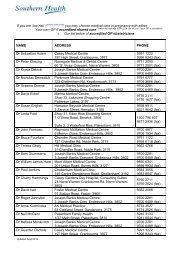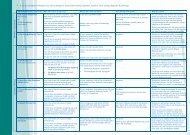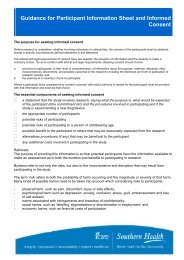national psychographicartist paul marc joffe - Southern Health
national psychographicartist paul marc joffe - Southern Health
national psychographicartist paul marc joffe - Southern Health
Create successful ePaper yourself
Turn your PDF publications into a flip-book with our unique Google optimized e-Paper software.
“THE ULTIMATE WISDOM OF THE PHOTOGRAPHIC IMAGE IS TO SAY: “THERE IS THE PICTURE SURFACE,<br />
NOW THINK – OR RATHER FEEL, INTUIT – WHAT IS BEYOND IT, WHAT THE REALITY MUST BE IF IT LOOKS<br />
THIS WAY.” SUSAN SONTAG, ON PHOTOGRAPHY<br />
KIRSTEN RANN<br />
NATIONAL PSYCHOGRAPHIC ARTIST PAUL MARC JOFFE<br />
24 PHOTOFILE PHOTOFILE 25
THE DIRECTNESS OF HIS IMAGES ARE DERIVED OUT OF WHAT HE FEELS IN RESPONSE TO ANY GIVEN MOMENT OR SITUATION OR, AS HE SAYS: “(AT) TIMES<br />
I MIGHT SEE A SIDEWAYS GLANCE, POSTURE, SYMMETRY AND JUST STEAL IT...” RATHER THAN ATTEMPTING TO CONVEY THE UNIVERSAL HUMAN EXPERIENCE,<br />
AS THE EARLY 20TH CENTURY AMERICAN PHOTOGRAPHERS DID, EACH OF JOFFE’S WORKS CONTAIN THEIR OWN SUBTEXT, NOT ONLY INDIVIDUALISING THE<br />
LIVES, CONTEXTS AND MOMENTS HE CAPTURES, BUT WHAT HE EXPERIENCES, PRESENTING US WITH AN EVOCATIVE, THOUGH GENTLE, EVALUATION OF<br />
A WORLD, AND LIFE, BEYOND HIS OWN.<br />
The number of photographs that can be taken<br />
of anything is infinite. And so it is with the<br />
subject matter covered by Paul Marc Joffe. There<br />
is a certain familiarity with his images, taken<br />
while travelling to somewhat unusual holiday<br />
destinations such as Durban, Mornington Island,<br />
Laos, Johannesburg, Cape Town, the Israel-<br />
Syrian border and so forth. These are places<br />
that reek of social inequality – through poverty,<br />
various forms of marginalisation, geography,<br />
age, religious belief and even, in some<br />
circumstances, racism. But rather than travel to<br />
bustling cities offering capitalist enterprise or<br />
lush holiday settings, such places enable Joffe<br />
to take the images he must, permeating as they<br />
do with sensitivity and the distant empathy<br />
characteristic of lens-based observation as he<br />
invites the viewer to consider what is happening<br />
in these places on a day-to-day basis.<br />
A self-taught photographer, beginning<br />
around the age of 20 whilst studying medicine<br />
at university, Joffe seems to have an instinct<br />
for subject matter, composition, colour, line…<br />
the conventional elements of photography<br />
emphasised by early 19th Century American<br />
photographers such as Walker Evans and Robert<br />
Frank or the Hungarian-French photographer<br />
Brassai, who, like Joffe, was attracted to<br />
picturesque depictions of what Sontag describes<br />
as the “desolation and damages of urban life”.<br />
But behind Joffe’s aesthetic sensibility seems<br />
to lie a generous acceptance of the world and all<br />
that happens in, or on, it.<br />
At times bleak, there is a poignant and<br />
sometimes poetic beauty in the reality of the<br />
lives or places he depicts, a beauty reminiscent<br />
of the enduring “triumph” of photography that<br />
Sontag suggests exists in depictions of “the<br />
humble, the inane, the decrepit.” Like Brassai’s<br />
photograph Sleeping Tramp in Marseilles<br />
(1935) or Walker Evans and Dorothea Lange’s<br />
New Deal Farm Security Administration<br />
photographs of rural poverty during the<br />
Depression of the 1920s and ’30s, Joffe’s<br />
Les Tueurs Melomanes (The Accordionist),<br />
Mthatha (2008), for example, captures a<br />
moment on a street corner in a dangerous part<br />
of Mthatha, the main town in the Eastern Cape<br />
province of South Africa. Sitting on the outside<br />
steps of a corner store, a blind accordion player<br />
is kindly given a cabbage by a stranger, who<br />
runs away and hides, and whose legs can be<br />
seen around the corner.<br />
An interesting point to note here is<br />
PREVIOUS SPREAD<br />
Such Soft Hands, Durban,<br />
2008<br />
Pigment ink on cotton rag<br />
160 x 107cm<br />
FACING PAGE TOP<br />
Beauty Spot (Right Cheek),<br />
Quneitra, Israel-Syria border,<br />
2007<br />
Pigment ink on cotton rag<br />
107 x 71cm<br />
the framing of Joffe’s works. Unlike the<br />
aforementioned American photographers,<br />
many of whom took portraits focusing on the<br />
desired character or expression on the faces of<br />
their subjects, Joffe, like Brassai, incorporates<br />
the composition of the individuals or objects<br />
within their environment, making the<br />
surrounds as important as the subject unless<br />
– as in Beauty Spot (Right Cheek), Quneitra,<br />
Israel-Syria border (2007) – he focuses on the<br />
environment itself. While giving his work a<br />
fine art leaning – rather than straight photodocumentary<br />
or journalism, where the content<br />
is more important than the aesthetic – he<br />
also opens up the possibility for different<br />
narrative interpretations.<br />
It is the documentary style favoured<br />
by Joffe that gives his work the sense of<br />
familiarity discussed earlier. Animate or<br />
inanimate, object(s) or person(s) – working,<br />
sitting, praying, waiting, playing, watching…<br />
his unpretentious images of streets and<br />
alleyways, walls, shop fronts, or of the locals<br />
going about their daily business in the areas<br />
he wanders around when he’s not being a<br />
pediatrician are remarkably often taken in<br />
one shot, though rather than waiting for that<br />
Cartier Bresson ‘decisive moment’, Joffe, who<br />
always carries one or several cameras with him<br />
(preferring the old analogue SLRs and TLRs<br />
to digital cameras, and not always knowing<br />
what he has taken until he arrives home and<br />
the films are developed), so that if and when<br />
he sees something he can take the photograph<br />
then and there.<br />
In an interview in December 2009,<br />
Joffe informed me that while chance is an<br />
important element in the way he works, “every<br />
photograph has a story”. Choosing his subjects<br />
for what they mean to him when he thinks<br />
of them, as well as what others may think,<br />
they are converted into images and alluded<br />
to in his titles, almost diaristically, including<br />
the locations in which they were taken, for<br />
example Untitled Reflection. Arab Contractors<br />
(rear), Wailing Wall, Jerusalem (2007) within<br />
which a group of Arab contractors who are<br />
doing repairs on The Wailing Wall in Jerusalem<br />
(or the Western Wall, as it is referred to<br />
there) stand in the background. Contrasted<br />
against this is a young Jewish man in<br />
traditional Orthodox dress who seems deep<br />
in contemplation as he walks across the square<br />
in front of the Wall and closer to the camera.<br />
FACING PAGE BOTTOM<br />
Les Tueurs Melomanes (The<br />
Accordionist), Mthatha, 2008<br />
Pigment ink on cotton rag<br />
107 x 71cm<br />
This observation-cum-image simply and<br />
directly conveys the socio-political difference<br />
between the two populations living and/or<br />
working in Jerusalem. It evokes speculation:<br />
perhaps these young men even have to cross<br />
the Gaza border patrol to go to work and return<br />
home each day?<br />
At times one wonders how it is that Joffe<br />
does not get shot, beaten up or robbed in some<br />
of the areas he walks to find his images. As<br />
he says: “If in a more dangerous area, I tend<br />
to observe and shift my perspective – I tend to<br />
interact for a number of hours prior to taking<br />
any shots – invariably a longer process but<br />
necessary both for my safety and the power of<br />
the resultant image.” Such might be the case in<br />
say, Deal, Approach Two, Green Market Square,<br />
Cape Town (2008), in which three sets of male<br />
hands and three hands of cards being dealt in<br />
a car boot suggest gambling, money, gangs and<br />
violence, but which was much more likely in<br />
the situation he put himself into to take Such<br />
Soft Hands, Durban (2008). During a week’s<br />
stay in the city, Joffe describes wandering this<br />
“palpably tense” area where he spotted a group<br />
of teenage boys. Not looking particularly rough<br />
in the way they dressed, he found himself<br />
intrigued by the contrast between their ‘soft<br />
hands’, the way they moved and a feeling<br />
that they were disconcerted or anxious about<br />
something, so he hung around to observe. On<br />
seeing something silver as they walked, he<br />
moved towards them and crossed their path in<br />
an oblique manner while discretely lining up<br />
the camera at hip height to take another of his<br />
remarkable single ‘shots’ (no pun intended)<br />
from their necks down. But as he asserts, most<br />
of the time he introduces himself and informs<br />
his potential subjects that he is there to take<br />
photographs, marvellously gaining their<br />
respect and/or trust.<br />
While themes of street and/or gang culture<br />
are comparable to cinematic genres, works<br />
such as Saudade, Bus Stop, Baixa Chiado,<br />
Lisboa (2005) - where two people, perhaps a<br />
couple, are seen sitting on a bench-seat behind<br />
(or in front of) a pane of frosted glass in a busstop<br />
– and Yeshiva (sitting) at Midnight, Tzfat<br />
(2007) – with four dedicated Orthodox Jewish<br />
men scattered about a room at midnight in<br />
a Yeshiva, an institution for the study of the<br />
Torah and other Rabbinical texts – are isolated<br />
incidences that are in complete contrast.<br />
The directness of his images are derived out<br />
26 PHOTOFILE PHOTOFILE 27
28 PHOTOFILE PHOTOFILE 29
PREVIOUS SPREAD<br />
Untitled Reflection. Arab<br />
Contractors (rear), Wailing<br />
Wall, Jerusalem, 2007<br />
Pigment ink on cotton rag<br />
107 x 71cm<br />
ABOVE<br />
Saudade, Bus Stop, Baixa<br />
Chiado, Lisboa, 2005<br />
Pigment ink on cotton rag<br />
107 x 71cm<br />
BELOW<br />
Movement Untitled<br />
(Second), Imizamo Yethu,<br />
Cape Town, 2003<br />
Pigment ink on cotton rag<br />
160 x 107cm<br />
FACING PAGE<br />
Movement Untitled,<br />
Mornington Island,<br />
Queensland, 2004<br />
Pigment ink on cotton rag<br />
107 x 71cm<br />
of what he feels in response to any given<br />
moment or situation or, as he says: “(at)<br />
times I might see a sideways glance, posture,<br />
symmetry and just steal it...” Rather than<br />
attempting to convey the universal human<br />
experience, as the early 20th Century<br />
American photographers did, each of Joffe’s<br />
works contain their own subtext, not only<br />
individualising the lives, contexts and<br />
moments he captures, but what he experiences,<br />
presenting us with an evocative, though gentle,<br />
evaluation of a world, and life, beyond his own.<br />
A particular example exists in his<br />
photograph Movement Untitled, Mornington<br />
Island, Queensland, (2004), taken in a single<br />
shot during a 10-week medical training<br />
placement he had in a hospital on the island<br />
but which was brought to a halt early and<br />
for which, according to Joffe in a recent<br />
email, “there were no reasons given – from our<br />
preceptors, from Mt Isa, from the Queensland<br />
government – as to why I was evacuated from<br />
the Island.” And while most of the white<br />
population had to live in a compound, Joffe’s<br />
association with an ABC documentary team<br />
(both as documentary subject and volunteer<br />
photographer) while he was there enabled<br />
him to wander outside with his camera in<br />
the evenings and take photographs and visit<br />
members of the community. This mingling<br />
with the locals, including occasions when<br />
he played music with them, had some rather<br />
extraordinary outcomes, as he describes how<br />
the Mornington Island image came about:<br />
“Mornington Island was a complex and sensitive<br />
time. The ABC documentary (w2004) and its<br />
content – Indigenous health, western affluence,<br />
the thick bridge between youth suicide, abuse,<br />
alcoholism, 100 years of occupation – continues to<br />
influence rural and indigenous health training.<br />
“I was invited to the land of a local<br />
family. A young man watched me as I enter<br />
his property. Inside, the Muyinda (Elders)<br />
talk of the township centre, Gununa,<br />
beginning as a Presbyterian Mission in<br />
1914 – an amalgamation of communities from<br />
neighbouring islands as well as many stolen<br />
children from the mainland. I learnt of the<br />
26 island clans, and sitting on the floor next<br />
to some used cans and a Twisties packet I<br />
learnt of Thuwatu and the ‘malkiri’ spirit, of<br />
how to stay safe and how to perish by the<br />
laws of the land. I learnt of their totem – the<br />
‘dreaming spirit’ – conceptually and physically<br />
– understanding how to communicate between<br />
skin groups.<br />
“I was given a gift. For the rest of my time on<br />
this Island I was referred to as ‘Gunjin’ (Wallaby)<br />
– a sign of trust, and in this case, of humour<br />
(some would laugh hysterically as I was chased<br />
and near-savaged by the local dogs on two<br />
occasions in one day, like a ‘white wallaby’).<br />
“This photo was on leaving the house. The<br />
young man was still waiting in the garden.<br />
Without exchanging words he jumps, contorts,<br />
striking the air. I have time to capture the dust<br />
following him. I still do not understand why.”<br />
With its unusual angle focusing on where<br />
the subject’s feet should have been rather than<br />
where they were going, was this young man’s<br />
move a playful reference to the wallaby, or<br />
something like a Tom Jones “Think I’m gonna<br />
dance now!” moment, or perhaps he was drunk,<br />
or stoned, or was it a display of something<br />
more menacing?<br />
Though digital manipulation increasingly<br />
blurs the lines between fact and fiction,<br />
Joffe, like many others, continues to seek the<br />
‘real’ – as in what the human eye sees – and<br />
rarely ‘touches up’ his photographs unless<br />
it’s with regards to colour. According to<br />
Sontag, this kind of ‘real’ is “generally sought<br />
among the anonymous, the poor, the socially<br />
defenseless, the aged... people indifferent or<br />
powerless to the camera’s aggression” (On<br />
Photography, p.104). While this could be said<br />
to pertain to Joffe’s work, he is a basically a<br />
political animal who tries to keep the camera<br />
as unaggressive, or unobtrusive, as he can to<br />
allow the situations he comes across to be as<br />
unaffected, or honest, as possible. As a result,<br />
it seems his subjects recognise him as an<br />
intense and focused young man who, though<br />
loaded with a camera, possesses sensitivity<br />
towards, and respect for, those he mingles<br />
amongst. This could be said to be apparent<br />
in Movement Untitled (Second), Imizamo<br />
Yethu, Cape Town (2003), where four children<br />
in a street that he describes as reeking with<br />
violence, seem to trust that he is harmless and<br />
continue playing, while some gang members<br />
hovering in the background watch and leave<br />
him to his own devices.<br />
Joffe’s photography presents a way of seeing<br />
that is precise, intelligent and even scientific,<br />
both in an anthropological sense – mapping<br />
human life – and in the sense conveyed in<br />
an email regarding the title of his exhibition<br />
(Inferior Oblique, held at Lindberg Contemporary<br />
Art in Melbourne during November 2009)<br />
that it “alludes to both the anatomical context<br />
(the name of a small muscle attached to the<br />
eye – responsible for part of its movement/<br />
rotation – which aids in an appropriate field of<br />
vision through a camera)”, but which also relates<br />
to “the subject matter to the artistic ‘direction’”<br />
of his work. And while his images convey a<br />
particular vision of the world, or reality, they<br />
also resemble a scientific collection of samples<br />
of his experiences that incite the viewer to think,<br />
or feel, about what is happening both inside and<br />
outside the frame.<br />
30 PHOTOFILE PHOTOFILE 31






